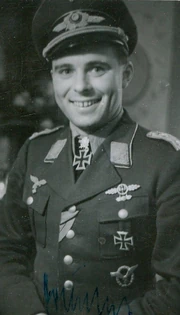| Alfred Druschel | |
|---|---|
 Alfred Druschel | |
| Born | 4 February 1917 |
| Died | 1 January 1945 (aged 27) |
| Place of birth | Bindsachsen, District Büdingen |
| Place of death | near Aachen |
| Allegiance |
|
| Service/branch |
|
| Years of service | 1936-1945 |
| Rank | Oberst |
| Unit | LG 2, SG 1, SG 4 |
| Commands held | 2.(S)/LG 2, I./SG 1 |
| Battles/wars | |
| Awards | Knight's Cross of the Iron Cross with Oak Leaves and Swords |
Oberst Alfred Druschel (born 4 February 1917 in Bindsachsen, District Büdingen; Killed in action on 1 January 1945 near Aachen in Unternehmen Bodenplatte) was a German Luftwaffe combat pilot and Flying ace during World War II. He was the first combat pilot to be honored with the Knight's Cross of the Iron Cross with Oak Leaves and Swords (German language: Ritterkreuz des Eisernen Kreuzes mit Eichenlaub und Schwertern). The Knight's Cross of the Iron Cross and its higher grade Oak Leaves and Swords was awarded to recognise extreme battlefield bravery or successful military leadership.
Military career[]
He joined the Luftwaffe on 1 April 1936 as a Fahnenjunker. His training began at the Luftkriegsschule (Air War School) in Berlin-Gatow and Rangsdorf before he transferred to the Kampffliegerschule (Combat Fliers School) at Tutow and Fassberg. Beginning on 1 March 1938 Leutnant Druschel was and trained as an observer and then as a staff officer with a Luftflotte (Air Fleet). on 1 July 1938, Druschel was posted to Fliegergruppe 20, which was renamed II.(S)/Lehrgeschwader 2 (LG 2—2nd Demonstration Wing) in November 1938. He served with 4./LG 2 during the invasion of Poland and the battle of France, flying the Henschel Hs 123 biplane. The unit spearheaded many of the crucial battles during these campaigns. Druschel was awarded the Iron Cross 2nd class in September 1939 and the Iron Cross 1st class in May 1940. Druschel became Staffelkapitän of 4.(S)/LG 2 in September 1940, leading the unit on fighter-bomber missions against targets in England and on shipping in the Channel. In April 1941, 4.(S)/LG 2 operated over southern Yugoslavia and Greece and took part during the invasion of Russia. Oberleutnant Druschel was awarded the Ritterkreuz in August 1941 for 7 aerial victories and for flying over 200 missions. He operated over the Eastern front until October 1943 with 4.(Schl)/LG 2 and from autumn 1941 as Staffelkapitän, 2./SG 1. In early 1942 he became Gruppenkommandeur of I./Schlachtgeschwader 1 (SG 1) and by October 1943 was Geschwaderkommodore of SG 1. Hauptmann Druschel was awarded the Oakleaves in September 1942 for 600 combat missions and the Swords in February 1943 for over 700 combat missions. In October 1943, Druschel was appointed Inspizient der Tag-Schlachtfliegerverbände. He was promoted to Oberstleutnant in April 1944, and made Kommodore of SG 4 based in the west in December 1944. On 1 January 1945, Druschel participated in Unternehmen Bodenplatte, the attack on the Allied airfields in the Netherlands and Belgium. Accompanied by JG 2, SG 4, Druschel led an attack on St Trond in Belgium. He became separated from his formation following a heavy flak attack and remains missing to this day in the area south of Aachen.
Alfred Druschel was officially credited with seven aerial victories claimed in over 800 combat missions, he mainly flew ground support missions in Henschel Hs 123, Bf 109 and Fw 190 fighter-bombers.[Note 1]
Awards[]
- Wound Badge in Black
- Front Flying Clasp of the Luftwaffe in Gold with Pennant "800"
- Combined Pilots-Observation Badge in Gold with Diamonds
- Ehrenpokal der Luftwaffe
- Iron Cross (1939)
- Knight's Cross of the Iron Cross with Oak Leaves and Swords
- Knight's Cross on 21 August 1941 as Oberleutnant and Staffelkapitän of the 2./(S)LG 2[2][Note 2]
- 118th Oak Leaves on 3 September 1942 as Hauptmann and Gruppenkommandeur of the I./SG 1[4][Note 3]
- 24th Swords on 19 February 1943 as Hauptmann and deputy Gruppenkommandeur of the I./SG 1[3][5]
Notes[]
- ↑ For a list of Luftwaffe ground attack aces see List of German World War II Ground Attack aces
- ↑ According to Scherzer as Staffelkapitän of the 4.(S)/Lehrgeschwader 2.[3]
- ↑ According to Scherzer as Oberleutnant.[3]
References[]
- Citations
- Bibliography
- Berger, Florian (2000). Mit Eichenlaub und Schwertern. Die höchstdekorierten Soldaten des Zweiten Weltkrieges. Selbstverlag Florian Berger. ISBN 3-9501307-0-5.
- Brütting, Georg (1995). Das waren die deutschen Stuka-Asse 1939 - 1945. Motorbuch, Stuttgart. ISBN 3-87943-433-6.
- Fellgiebel, Walther-Peer (2000). Die Träger des Ritterkreuzes des Eisernen Kreuzes 1939-1945. Friedburg, Germany: Podzun-Pallas. ISBN 3-7909-0284-5.
- MacLean, French L. (2007). Luftwaffe Efficiency & Promotion Reports — For the Knight's Cross Winners. Atglen, Pennsylvania: Schiffer Military History. ISBN 978-0-7643-2657-8.
- Obermaier, Ernst (1976). Die Ritterkreuzträger der Luftwaffe 1939-1945 Band II Stuka- und Schlachtflieger (in German). Mainz, Germany: Verlag Dieter Hoffmann. ISBN 3-87341-021-4.
- Scherzer, Veit (2007). Die Ritterkreuzträger 1939–1945 Die Inhaber des Ritterkreuzes des Eisernen Kreuzes 1939 von Heer, Luftwaffe, Kriegsmarine, Waffen-SS, Volkssturm sowie mit Deutschland verbündeter Streitkräfte nach den Unterlagen des Bundesarchives (in German). Jena, Germany: Scherzers Miltaer-Verlag. ISBN 978-3-938845-17-2.
- Schaulen, Fritjof (2003). Eichenlaubträger 1940 - 1945 Zeitgeschichte in Farbe I Abraham - Huppertz (in German). Selent, Germany: Pour le Mérite. ISBN 3-932381-20-3.
- Frey, Gerhard; Herrmann, Hajo: Helden der Wehrmacht - Unsterbliche deutsche Soldaten (in German). München, Germany: FZ-Verlag GmbH, 2004. ISBN 3-924309-53-1.
External links[]
- "Aces of the Luftwaffe". Alfred Druschel. http://www.luftwaffe.cz/druschel.html. Retrieved 8 June 2007.
- "das-ritterkreuz.de". Alfred Druschel. http://www.das-ritterkreuz.de/index_search_db.php4?modul=search_result_det&wert1=1136&searchword=druschel. Retrieved 8 June 2007.
- "Lexikon der Wehrmacht". Alfred Druschel. http://www.lexikon-der-wehrmacht.de/Personenregister/D/DruschelA.htm. Retrieved 8 June 2007.
| ||||||||
| |||||
The original article can be found at Alfred Druschel and the edit history here.
